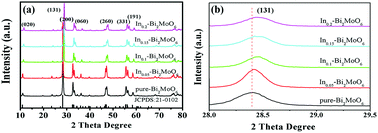Defect state of indium-doped bismuth molybdate nanosheets for enhanced photoreduction of chromium(vi) under visible light illumination†
Abstract
The construction of defect states is an effective method for regulating the energy band structure of photocatalytic semiconductor materials. Establishing defect states effectively is a particularly significant strategy to improve the photoelectric conversion efficiency. Herein, we report a peculiar method to manufacture defect states in indium-doped Bi2MoO6 by changing the valence state of the doped indium element. By increasing the amount of doped indium, different doping forms and valence states are produced, which causes distortion of crystal structure, generation of oxygen vacancies and variation in the elemental valence state. Specifically, when Bi is substituted with In(3−x)+, the acceptor energy level becomes higher than the valence band due to the p-type-like doping, which widens the width of the valence band and drives the up-shift of the valence band edges, resulting in narrowed bandgap and improved photoresponse ability. In addition, the photoelectrochemical performance tests using the In-doped Bi2MoO6 show that low-valent indium doping effectively improves the carrier separation efficiency, reduces the transmission impedance, and greatly improves the photocatalytic reduction performance of Cr(VI). This study provides a new insight to the design of efficient photocatalysts for the green and sustainable treatment of Cr(VI) pollution.



 Please wait while we load your content...
Please wait while we load your content...